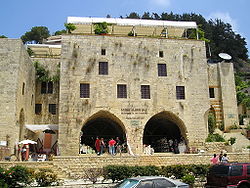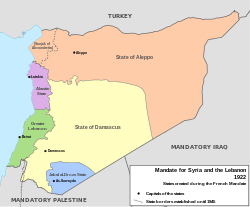Lebanon
Lebanon is a country in the Middle East, in Western Asia, next to the Mediterranean Sea. It has borders with Israel to the south and Syria to the east and north. It also shares a maritime border with Cyprus to the northwest, away from the country's short distance.
Republic of Lebanon | |
|---|---|
| Anthem: | |
 Location of Lebanon (in green) | |
 | |
| Capital and largest city | Beirut 33°54′N 35°32′E / 33.900°N 35.533°E |
| Official languages | Arabic[nb 1] |
| Lebanese Arabic | |
| Ethnic groups | |
| Religion (Estimated[nb 4]) |
|
| Demonym(s) | Lebanese |
| Government | Unitary confessionalist parliamentary republic[7] |
| Joseph Aoun | |
| Najib Mikati | |
| Nabih Berri | |
| Legislature | Parliament |
| Establishment | |
| 1 September 1920 | |
| 23 May 1926 | |
• Independence declared | 22 November 1943 |
• French mandate ended | 24 October 1945 |
• Withdrawal of French forces | 17 April 1946 |
| 24 May 2000 | |
| 30 April 2005 | |
| Area | |
• Total | 10,452 km2 (4,036 sq mi) (161st) |
• Water (%) | 1.8 |
| Population | |
• 2016 estimate | 6,006,668[8] (109th) |
• Density | 560/km2 (1,450.4/sq mi) (21st) |
| GDP (PPP) | 2020 estimate |
• Total | $91 billion[9] |
• Per capita | $11,562[9] (66th) |
| GDP (nominal) | 2020 estimate |
• Total | $18 billion[9] (82nd) |
• Per capita | $2,745[9] |
| Gini (2011) | ▼ 31.8[10] medium |
| HDI (2019) | high · 92nd |
| Currency | Lebanese pound (LBP) |
| Time zone | UTC+2 (EET) |
• Summer (DST) | UTC+3 (EEST) |
| Driving side | right[12] |
| Calling code | +961[13] |
| ISO 3166 code | LB |
| Internet TLD | .lb |
History & Data
Lebanon was named Phoenicia under the Roman Empire. Some of the biggest temples in Antiquity were there at Heliopolis. In the 7th century Arabs conquered Phoenicia and imposed their religion Islam. But many areas in the mountains remained Christian as the "Maronites". However, the Christians who remained in the mountains became Arabized and started identifying themselves as "Arab Christians".
Lebanon has been independent since 22 November 1943. Its capital city is Beirut.
Lebanon has two chains of mountains. It has a long coastline. The area of Lebanon is 10,452 square kilometers (4,036 square miles).
The Cedar tree is the national symbol of Lebanon because many of them grow in the Lebanon Mountains.
Population of Lebanon
Around 5.2 million people live in Lebanon.[14]
Around 14 million Lebanese people live outside Lebanon. [15]
The people of Lebanon
About 68% of Lebanese people are Muslim and 32% are Christian.[14]
The official language of Lebanon is Arabic and it is the most common language.[16] French, English, and Armenian are also common languages.
Governorates and districts
Lebanon is divided into six governorates. These are divided into 25 districts.[17] The districts are also divided into several municipalities. The governorates and their districts are listed below:
- Beirut Governorate
- The Beirut Governorate is not divided into districts and is limited to the city of Beirut
- Nabatieh Governorate (Jabal Amel)
- Beqaa Governorate
- Baalbek
- Hermel
- Rashaya
- Western Beqaa (al-Beqaa al-Gharbi)
- Zahle
- North Governorate (al-Shamal)
- Mount Lebanon Governorate (Jabal Lubnan)
- South Governorate (al-Janoub)

Lebanon Media
National Anthem of Lebanon
The Fall of Tripoli to the Egyptian Mamluks and destruction of the Crusader state, the County of Tripoli, 1289
Map of the French Mandate and the states created in 1920
Martyrs' Square in Beirut during celebrations marking the release by the French of Lebanon's government from Rashayya prison on 22 November 1943
Under Fouad Chehab, Lebanon experienced economic growth and sectarian harmony
Related pages
Notes
- ↑ Article 11 of the Constitution of Lebanon states: "Arabic is the official national language. A law shall determine the cases in which the French language can be used." See: French language in Lebanon
- ↑ Note: Many Lebanese Christians do not identify as "Arab" but rather as descendants of the ancient Canaanites and prefer to be called "Phoenician".
- ↑ Note: Most Druze do not identify as Muslim, but Druze are classified by the Lebanese government as one of the five Muslim communities in Lebanon (Sunni, Shia, Druze, Alawi, and Ismaili).
- ↑ Because the relative sizes of different religions and religious sects remains a sensitive issue, a national census has not been conducted since 1932. There are 18 state-recognized religious sects – four Muslim, 12 Christian, one Druze, and one Jewish
References
- ↑ "Lebanon 2017 International Religious Freedom Report" (PDF). United States Department of State. Retrieved 22 August 2021.
- ↑ "International Religious Freedom Report 2008: Lebanon". United States Department of State. 19 September 2008. Retrieved August 22, 2021.
- ↑ "International Religious Freedom Report 2010: Lebanon". United States Department of State. Archived from the original on 23 November 2010. Retrieved 22 August 2021.
- ↑ "International Religious Freedom Report for 2012: Lebanon". United States Department of State. Retrieved 22 August 2021.
- ↑ Meguerditchian, Van (15 February 2013). "Minority sects demand greater representation in Parliament". The Daily Star Lebanon. Archived from the original on 5 August 2021. Retrieved 22 August 2021.
- ↑ Haddad, Antoine (September 2006). "Evangelicals in Lebanon". Evangelical Times. Retrieved 22 August 2021.
- ↑ "The Lebanese Constitution" (PDF). Presidency of Lebanon. Archived from the original (PDF) on 19 January 2012. Retrieved 20 August 2011.
- ↑ "World Population Prospects: The 2017 Revision". ESA.UN.org (custom data acquired via website). United Nations Department of Economic and Social Affairs, Population Division. Retrieved 10 September 2017.
- ↑ 9.0 9.1 9.2 9.3 "Lebanon". International Monetary Fund. Retrieved 20 October 2019.
- ↑ "Gini Index coefficient". CIA World Factbook. Retrieved 16 July 2021.
- ↑ "Human Development Report 2019". United Nations Development Programme. 10 December 2019. Archived from the original (PDF) on 30 April 2020. Retrieved 10 December 2019.
- ↑ "Driving in Lebanon". adcidl.com. Archived from the original on 17 January 2013. Retrieved 17 January 2013.
- ↑ Lebanon. The World Factbook. Central Intelligence Agency.
- ↑ 14.0 14.1 "The World Factbook". CIA. United States government. July 2021.
- ↑ "The Lebanese Diaspora: An Exploration of Assimilation and Success in the United States". March 2018.
- ↑ Corm, Georges (2012). Le Liban contemporain : histoire et société (Édition revue et augmentée ed.). Paris. ISBN 978-2-7071-7357-7. OCLC 801063067.
- ↑ USAID Lebanon. "USAID Lebanon—Definitions of Terms used" Archived 2007-01-27 at the Wayback Machine. Retrieved 17 December 2006.








